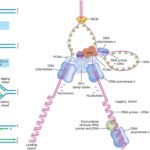IGCSE Biology 109 Views 1 Answers
Sourav PanLv 9November 14, 2024
Describe the structure of a bacterial cell, limited to: cell wall, cell membrane, cytoplasm, ribosomes, circular DNA, plasmids
Describe the structure of a bacterial cell, limited to: cell wall, cell membrane, cytoplasm, ribosomes, circular DNA, plasmids
Please login to save the post
15
Please login to submit an answer.
Sourav PanLv 9May 15, 2025
Bacterial cells are prokaryotic organisms characterized by their simple structure compared to eukaryotic cells. Here’s a detailed description of the key components of a bacterial cell, focusing on the specified structures:
Structure of a Bacterial Cell
- Cell Wall:
- The cell wall is a rigid outer layer that provides structural support and protection to the bacterial cell. It is primarily composed of peptidoglycan, a polymer consisting of sugars and amino acids. The thickness and composition of the cell wall can vary among different bacterial species, influencing their classification into Gram-positive or Gram-negative bacteria. Gram-positive bacteria have a thick peptidoglycan layer, while Gram-negative bacteria have a thinner layer and an additional outer membrane.
- Cell Membrane:
- The cell membrane, also known as the plasma membrane, lies just inside the cell wall. It is a semi-permeable lipid bilayer that controls the movement of substances in and out of the cell. The cell membrane contains proteins that facilitate transport and communication, as well as enzymes involved in metabolic processes.
- Cytoplasm:
- The cytoplasm is a gel-like substance that fills the interior of the bacterial cell. It contains water, salts, and various organic molecules. The cytoplasm houses all the cellular components and is the site for many metabolic reactions necessary for the bacterium’s survival and growth.
- Ribosomes:
- Bacterial ribosomes are smaller than those found in eukaryotic cells (70S ribosomes compared to 80S in eukaryotes). They are responsible for protein synthesis, translating messenger RNA (mRNA) into proteins. Ribosomes are freely suspended in the cytoplasm and play a crucial role in the bacterium’s ability to produce proteins necessary for its functions.
- Circular DNA:
- Bacteria possess a single, circular strand of DNA that contains their genetic information. This circular DNA is located in a region called the nucleoid, which is not membrane-bound. The DNA carries genes that encode proteins essential for various cellular functions, including metabolism, growth, and reproduction.
- Plasmids:
- Plasmids are small, circular pieces of DNA separate from the chromosomal DNA found in the nucleoid. They can replicate independently and often carry genes that provide additional traits to the bacterium, such as antibiotic resistance or metabolic capabilities. Plasmids can be transferred between bacteria through processes like conjugation, contributing to genetic diversity within bacterial populations.
Summary
In summary, a bacterial cell consists of several key structures:
- Cell Wall: Provides rigidity and protection; composed mainly of peptidoglycan.
- Cell Membrane: Semi-permeable barrier controlling substance movement.
- Cytoplasm: Gel-like medium where metabolic processes occur.
- Ribosomes: Sites of protein synthesis; smaller than those in eukaryotic cells.
- Circular DNA: Main genetic material located in the nucleoid region.
- Plasmids: Extra-chromosomal DNA that can confer advantageous traits.
327
327 likes
- Share on Facebook
- Share on Twitter
- Share on LinkedIn
0 found this helpful out of 0 votes
Helpful: 0%
Helpful: 0%
Was this page helpful?




